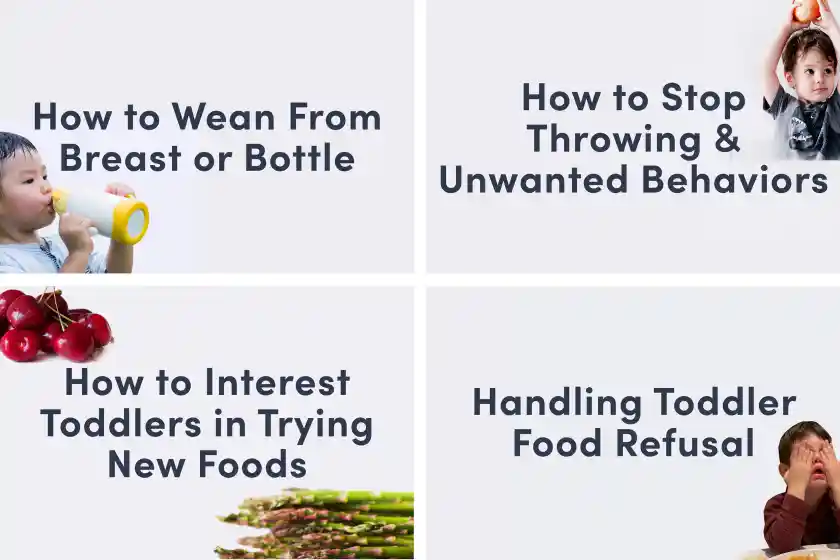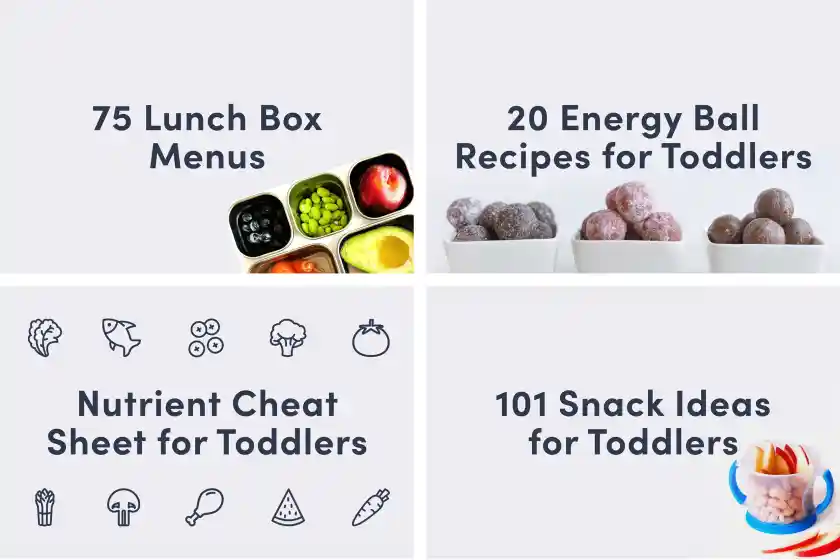Toddler FAQs

As exciting it can be to witness how babies become toddlers, it does come with a whole new set of challenges at the table. Our Toddler Bundle has everything you need to navigate the toddler years with grace.
When do I need to stop bottle feeding/formula/nursing?
Although it may seem very straightforward, this decision is complex. The governing medical bodies (AAP, WHO, CDC) vary in their recommendations. Most medical providers agree that sometime between 12-18 months, most toddlers no longer need nutritional support from human milk or formula. However, most toddlers benefit from continued support as they gain efficiency and success with chewing and managing a wide range of table foods.
By 2 years, most toddlers are completely weaned from bottles and formula, and chest/breast feeding is supplemental and encouraged as enjoyed by lactating parent and child. If you continue breast/chest feeding, consider whether nursing impacts the child’s hunger for table food and implement a fluid schedule around milk feeds and mealtimes, as needed.
See our article Weaning Breast/Chest Feeds & Bottles for more.
My toddler doesn't eat enough
While we may think we know when our child eats enough or doesn't, the only person with access to the child's hunger cues is the child. As parents and caregivers, we must respect the child’s hunger and satiety cues—even if we suspect they are wrong—and allow them to live with the natural consequences that may occur—i.e., hunger.
We can control three things:
What we serve
When we serve it
Our attitude around meals and eating
The child controls if they eat and how much.
Children will make mistakes—under-eating or overeating— but making mistakes is an important part of the learning process. If you suspect your child did not eat enough, consider asking: "Have you checked in with your belly to make sure it had enough to eat?" and leave it at that. If they request a snack soon after, remind them that food is not available right now, and say: "I wonder if you are feeling hungry because you didn't fill your belly enough during lunch?"
Forcing, encouraging, or making a child eat a certain amount will either:
Decrease the amount they eat overall as they seek to control and refuse food more often
Teach them that eating means pleasing their parents, which can lead to overeating and a child who doesn't listen to their body cues
My toddler hates meat/always spits out meat
Meat is a challenging texture, even for toddlers with more advanced eating skills. It’s not uncommon for toddlers to spit out meat because it's harder to chew.
Consider offering meat early in the day—breakfast or lunch—when the child has more endurance.
Try cutting the meat small or shredding it, and consider serving alongside big pieces like a bone-in pork chop for biting and tearing practice. Optionally, consider cooking meat so it softens quite a bit, like stewed or braised.
Finally, consider some meals where meat is the centerpiece and other options are limited to allow for hunger motivation to drive the toddler to do the hard work of chewing the meat.
My toddler only eats one thing on the plate, ignores other foods, and asks for more.
Continuing to re-fill their favorite foods when they haven't eaten other foods on the plate will not encourage them to explore less preferred or new foods. Serving the preferred food may decrease any initial anxiety around the meal, but when this serving is consistently re-filled, you remove the hunger motivation for the child to try anything else on the plate.
It is our strong professional opinion as feeding therapists to hold a boundary here:
“If you are still hungry, you have [the other foods] on your plate. If you are all done, that's okay too.”
Let the child decide.
Offer a fun incentive for the other foods—"Would you like a dip or sprinkle?”—but allowing them to fill up on their favorite dish is not going to provide motivation for them to taste or eat the other parts of the meal.
Check out our guide on Handling Toddler Food Refusals for more.
My toddler hates the high chair
It is common for toddlers, even as young as 12 months, to decide that the high chair is no longer for them. Consider the following:
If you haven't already, remove the tray and bring your toddler to the family table, This often significantly improves mealtime participation.
Let the child take movement breaks during the meal. Toddler bodies are made to move, and respecting that need can go a long way.
It may be time to move to a booster seat or another seating system. If you are currently using an infant padded high chair, it might be a good time to transition.
Check out the High Chair Transitions guide for more guidance, step-by-step recommendations on transitioning chairs, and scripts to manage toddler high chair issues.
Are weaning tables good for babies and toddlers?
Weaning tables or low-rise tables made specifically for toddlers can be a great way to build independence, provide a safe place for a child to sit for play activities, and serve as an age-appropriate place for meals for kids older than 18-24 months who understand basic safety rules (i.e., Food stays at the table.).
While weaning tables are suitable and can be safe, they can also prevent valuable modeling that happens at the family table; consider reserving toddler tables for snack time and keep primary meals at the family table. Opportunities to sit independently during the day may be enough for a climbing or wiggly toddler to sit happily in their seat for family mealtimes. Check out our High Chair Transitions guide for more in-depth guidance.
My toddler throws food
Food throwing, although very irritating, is typical, developmentally normal toddler mealtime behavior. Consider the following when a toddler is throwing food:
Are they hungry for the meal?
Consider your feeding schedule, including any bottles or nursing sessions (including overnight), and any servings of cow's milk/milk alternative the child consumes throughout the day.
Many toddlers over-snack or drinking too much milk, which gets in the way of their hunger drive for meals.
Low hunger motivation and boredom will lead to throwing.
Set a boundary. Behavior is communication, so help your toddler learn that throwing communicates that they are all done with the meal. Are they all done? We don't know! But connecting the two will help them learn that if they throw, the meal ends. S
See the article Throwing Food or our guide How to Stop Throwing & Unwanted Behaviors for more.
How do I know if my toddler is picky or if they are just a typical toddler?
Mealtimes with toddlers can be challenging to say the least.
Toddlers go through a phase of neophobia, or fear of new foods, that can last a few years, which makes them much more hesitant to explore new foods than they were in infancy. They also have a slowing growth rate compared to infancy (and therefore less hunger) and a strong drive to practice new skills of moving around, testing boundaries, and being in control. All these things can contribute to a phase of less-than-ideal eating and new refusals at the table that look a lot like picky eating. This is considered toddler selectivity, and caution parents from treating this like true picky eating, as strategies used for treating true picky eating can often prolong and worsen toddler selectivity.
Picky eating, which takes toddler selectivity to a new level, tends to be related to underlying issues like anxiety or fear around food and/or meals, sensory processing, or developmental delay. Children who exhibit true picky eating behaviors need slow, consistent change and challenges, balanced with love, some additional accommodation, and support scaffolding to learn to tolerate a typical mealtime environment and explore new foods. This level of support tends to be too much for typically developing selective toddlers and may worsen behavior and rigidity, preventing them from making progress.
It's likely true picky eating if your toddler…
Is willing to starve themselves rather than eat a non-favorite food
Exhibits specific sensory sensitivities and/or challenges such as refusing to have messy hands, won’t touch wet or messy textures, or hates having hands washed, face washed, teeth brushed, etc.
Shows signs of severe anxiety at the table (meltdowns/tantrums are different from the meltdowns/tantrums that occur during other times like bedtime, transitions, etc.).
Behavior and refusals are consistent; they don’t come and go meal to meal, day to day, week to week, or from one caregiver to another.
Will not touch or interact with food at all even though pressure has been low and you’ve given them ample opportunities to go at their own pace *throwing counts as interacting*
Has been showing refusal behaviors and/or eating issues for 4-6mo+
See Is my child a picky eater? Toddler Selectivity vs Picky Eating for more.
My toddler refuses meals and then begs to nurse or will nurse at any time
This is a challenging yet common occurrence with toddlers who continue to chest/breast feed. Your child has had more than a year of practice nursing—it's a fast, efficient way to fill their belly, requires minimal work, and is a quiet, calming bonding activity in a busy toddler world. Chewing and swallowing are still developing skills requiring work and patience.
We are firm supporters of continued nursing for as long as the child and lactating parent desire, but some gentle boundaries may be needed if nursing interferes with eating nourishing table foods, which are important for healthy growth and development. These boundaries will look different for each lactating parent/child dyad, but if your toddler is refusing meals and then choosing to nurse, it may be important to set times of day when the chest/breast isn't available so the child learns to use table food to fill the belly.
See our Weaning Guide for a very detailed plan for managing these types of situations.
Guide + Recipe Kits
All included in the Toddlers Bundle
Ready to get started?
Download the app to start your journey.
Expert Tips Delivered to Your Inbox
Sign up for weekly tips, recipes and more!


